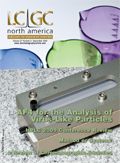Everything is Cyclical
LCGC North America
There is an old saying regarding the world of fashion that says if you wait long enough, everything comes back into style eventually. While this saying may have provided the necessary excuse for many people (myself included) to avoid throwing away favorite old articles of clothing, the underlying truth that everything is cyclical cannot be denied, and this certainly holds just as true for the field of chromatography as it does for any other field.
There is an old saying regarding the world of fashion that says if you wait long enough, everything comes back into style eventually. While this saying may have provided the necessary excuse for many people (myself included) to avoid throwing away favorite old articles of clothing, the underlying truth that everything is cyclical cannot be denied, and this certainly holds just as true for the field of chromatography as it does for any other field.

David Walsh
Earlier in the year, the stock market was at its lowest point in over ten years, and many feared the recession might even deepen into a depression. At the same time, the acetonitrile shortage was at its peak, with many laboratories feeling the crunch of this unexpected rise in the cost of solvent. Things looked grim, and the outlook was dark to say the least.
Now, just a few months later, that cycle has begun to shift and the wheels have begun turning in the right direction, albeit at a slow pace. The stock market, while nowhere near its highs from just a couple of years ago, has recovered at least some of its losses. And the supply of acetonitrile is slowly coming back as well, although all indications are that, like oil, the price may never return to the previous levels that many had become accustomed to.
Only time will tell if the cycle continues turning in this direction, but for now, it is safe to say that the outlook for the chromatography industry is discernibly brighter than it was when the year began. And as always, you can rely on LCGC to bring you the most reliable information on these issues and more, from the most respected and knowledgeable sources in the industry today — experts like Ron Majors, who addresses the ACN shortage and continued price spike in a special addendum to his column this month. This is a must-read for any reader whose daily work involves the use of this solvent.
Enjoy the issue.

David Walsh
Editor-in-Chief
David.Walsh@advanstar.com
A Novel LC–QTOF-MS DIA Method for Pesticide Quantification and Screening in Agricultural Waters
May 8th 2025Scientists from the University of Santiago de Compostela developed a liquid chromatography quadrupole time-of-flight mass spectrometry (LC–QTOF-MS) operated in data-independent acquisition (DIA) mode for pesticide quantification in agriculturally impacted waters.
Investigating 3D-Printable Stationary Phases in Liquid Chromatography
May 7th 20253D printing technology has potential in chromatography, but a major challenge is developing materials with both high porosity and robust mechanical properties. Recently, scientists compared the separation performances of eight different 3D printable stationary phases.

.png&w=3840&q=75)

.png&w=3840&q=75)



.png&w=3840&q=75)



.png&w=3840&q=75)











